Stakeholders provide the skills, insight, influence and sometimes resources needed to make a project successful. Some clear feedback or approval from your external and internal stakeholders may be all you need to take your marketing project to the next level. However, the major challenge that comes with having stakeholders is managing them.
As a project manager, you have to keep your stakeholders updated as the project progresses, get feedback on time and effect changes as requested, etc. This can be difficult, as you are dealing with different people, with varying personalities, interests and needs.
This article will serve as the ultimate guide to stakeholder management, to help you manage stakeholder expectations and reach your marketing project goals easily.
Who is a project stakeholder?
A project stakeholder is someone who is directly or indirectly involved in your project, or affected by it in a professional capacity. If you are part of an organization, project stakeholders could range from your team members to the CEO, product designers, or sales team. Identifying your key stakeholders and grouping them in the appropriate categories using stakeholder analysis, will help you manage them better.
Apart from the members of your project team, stakeholders can be grouped into two categories:
- Internal stakeholders: These professionals are members of your organization. They include project managers, members from the marketing, sales and product team, board of directors, compliance and legal managers, and anyone with an interest in the project.
- External stakeholders: These are professionals who are not in your organization but have a major impact on your project success. They include unions, a project sponsor, customers, suppliers, contractors, agencies, and even media companies.
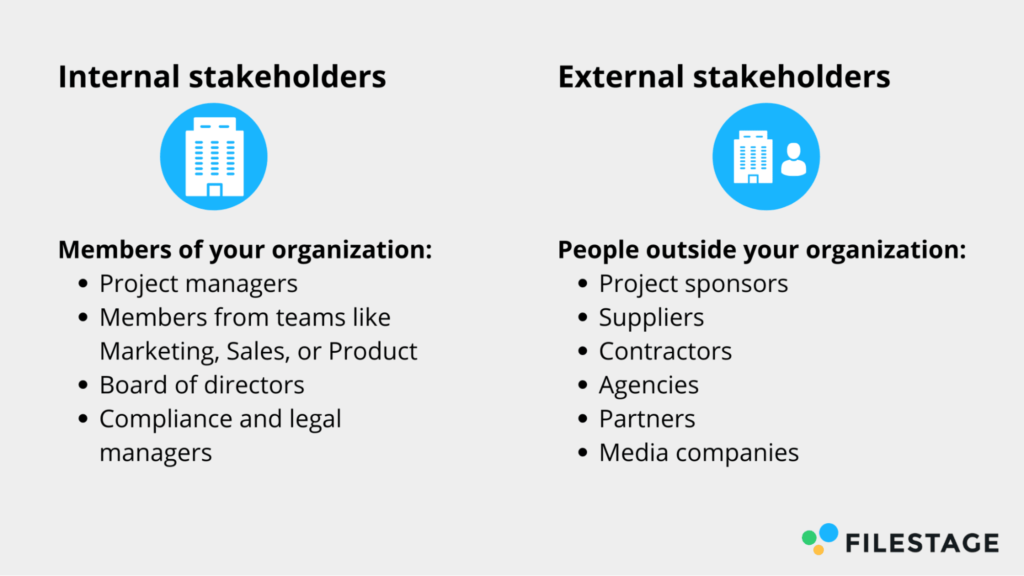
Knowing where each stakeholder belongs, the role they play, and how they relate to each other will help you understand stakeholder engagement, for quick project execution and success.
What is stakeholder management and why is it important?
Stakeholder management is the process and different techniques that project managers use to engage, manage, and guide the various stakeholders involved in a project.
Stakeholders can be any internal or external groups that might have a positive or negative impact on the outcome of your project.
The experienced project manager understands the difficulties that can arise when managing stakeholders. This can happen because, individually, each team member has their own personality, perspective, and priorities; and, as a group, they are impacted by broader trends within the workplace. Bruce Tulgan has outlined these as follows:
- The pace of work is increasing
- Workplaces struggle with training and wisdom transfer
- There are fewer layers of management today
- There is constant pressure to improve productivity and quality
- Teams are more interdependent than ever before
The project manager needs to mitigate the impact of those factors and carry out flawless stakeholder management. To do so, they’ll need to define a clear process, develop the right skills, and craft a winning plan.
What are the four Cs of stakeholder management?
The best way to go about stakeholder management is by being practical and conscious of it. A great stakeholder analysis and management process involves four major steps and we will explore them below.
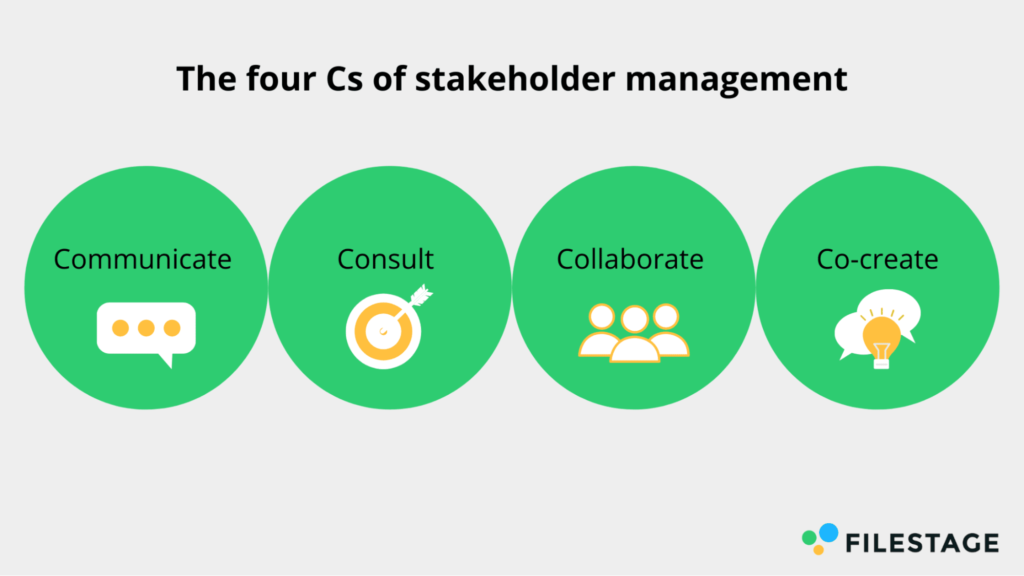
Communicate
An effective communication strategy is the best way to get the full support of your stakeholders for your project. This could mean having face to face meetings, communicating via email, or messaging systems like Slack. You need to find out which channel works best for each stakeholder, so you can share all relevant information with them.
Consult
Depending on how vital a stakeholder is to your project, you should definitely have initial consultation sessions. Here, you build rapport with them and map out the project direction and strategic objectives. Consulting different stakeholders at the points where they are needed, especially as the project begins, will help set clear expectations and put you on track with the resources required for success.
Collaborate
Effective collaboration with internal and external stakeholders is a great way to make them feel involved. A collaboration could range from brainstorming ideas to seeking their approval on critical aspects of the project. For some stakeholders, you may have to collaborate with them closely, while others prefer regular updates. The key is to fully engage them, build positive relationships, and keep them interested in your project.
Co-create
Co-creating is basically collaborating with external stakeholders and involving them in your project. It is a great way to get fresh ideas and insight into your project, while keeping stakeholders invested. It could range from customer engagement to media collaboration. Co-creating works best in the beginning phase of the project, as it helps to manage external stakeholders and brings more value to the project.
What is a stakeholder management strategy?
A stakeholder management strategy is a series of steps, aimed at maintaining a strong relationship with your stakeholders throughout the duration of a project.
It is a practical approach to increase the support of stakeholders, while minimizing any negative impact their involvement in a project might bring.
The involvement of stakeholders in your project can either streamline, slow down or stop its progress. This is why you must keep them updated and satisfied from beginning to completion, and the only way to achieve this is with a solid management strategy.
Comprehensive stakeholder analysis will provide complete knowledge of your stakeholders, including their concerns, priorities, and degree of involvement in the project. This information, which can be depicted in a stakeholder map, will help you anticipate their needs and guide you towards meeting them. It will also boost stakeholder engagement by determining how well and how often you communicate with your stakeholders for better project management.
A top management strategy for key stakeholders also helps you decide how to approach each individual or group and what communications channels work best for them.
The core principles of good management strategies are detailed stakeholder mapping and a solid communication plan. Once these principles are clear, managing stakeholder expectations is easier and the project team can successfully complete the project.
The four steps of the stakeholder management process
A great project stakeholder management process does not have to be confusing and ambiguous. It can be broken down into four practical steps that are easy to follow and accomplish. This way, you can tick each step off the list on completion and move on to the next one in no time.
There are four key steps:
1. Create your stakeholder management plan
2. Develop your communication and engagement plan
3. Monitor and update
4. Develop a grievance management process
Let’s explore each of those in more depth.
1. Create your stakeholder management plan
A stakeholder management plan helps you identify, document, and map stakeholders out. Further, you should prioritize them according to their needs and impact. At the end, you’ll have a single document with all the important information about your stakeholders.

Identify stakeholders
The first step is to identify the appropriate stakeholders. These are the people – internal or external – that you’ll need to communicate with over the course of the project.
They might include people, such as:
- 1. Employees
- 2. External partners (such as agencies)
- 3. Decision-makers
- 4. Shareholders
- 5. Customers
It’s important that you identify all the necessary stakeholders and collect accurate personal information along the way. This will help you to keep every single stakeholder in the loop from the very beginning of, and throughout, your project.
You should maintain a list of those stakeholders in an Excel or Google Sheets file (we’ll provide you with a useful template that you can use later).
Document your stakeholders
Once you have identified all the relevant stakeholders, you’ll need to collect important information about them. Some of this will include practical information, such as the stakeholder’s name and contact information.
However, you’ll also need to learn more about your stakeholders and record that information in the document you have created. These additional pieces of information might be more abstract, but they can help you manage your stakeholders more effectively.
Here are some questions you’ll want to be able to answer, in order to understand your stakeholders on a deeper level:
- 1. Why is this stakeholder interested in your project?
- 2. What motivates your stakeholders?
- 3. What information will this stakeholder need to receive over the course of the project?
- 4. Which communication channel(s) does this stakeholder prefer?
- 5. Is this stakeholder currently satisfied with your work?
- 6. What will influence these stakeholders’ opinion(s) of your work?
- 7. Who will influence the opinions of this stakeholder?
The answers to these questions will help you to see your project through your stakeholders’ perspectives. This, in turn, can help you manage, and communicate with them more effectively.
Stakeholder mapping
Now that you have a more vivid picture of your stakeholders, it’s time for you to assess their role within your project and to classify them. One way to do this is to place your stakeholders on a Power/Interest Grid.
The Power/Interest Grid helps you to position your stakeholders onto a grid, depending on their power over your project and their interest in it. This makes it easier for you to segment your stakeholders, so you can manage and communicate with them more effectively. For example, you might want to provide frequent and timely updates to one group of relevant stakeholders, while keeping communications to a minimum for the others.
Here’s a clear example of the Power/Interest Grid from Mind Tools:
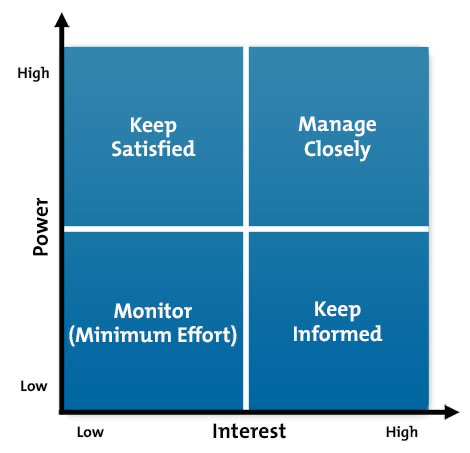
Here’s a breakdown of the four different groups within the Power/Interest Grid, and how you might deal with them:
- 1. High power, low interest: You’ll need to satisfy these stakeholders with quality work, but avoid boring them with frequent updates.
- 2. High power, high interest: You’ll need to engage these stakeholders fully, and try as hard as possible to satisfy them.
- 3. Low power, low interest: These stakeholders should be loosely monitored, but they don’t need to be provided with constant updates.
- 4. Low power, high interest: These stakeholders should be kept in the loop and they’re a useful resource when it comes to collecting feedback and input.
Prioritize your stakeholders
When you complete your stakeholder analysis, you can prioritize them, based on the degree of their interest in your project and the impact they have. This will help you channel your resources better.
With Filestage’s stakeholder management plan template, you can categorize stakeholders, based on their interest, power, their current mood about the project, and how often they need progress updates.
The filled-out template clearly shows you which stakeholders are satisfied and which ones need better management. Not all stakeholders will have a significant impact on your project, and this is where stakeholder analysis helps.
Download our free template right here:
For example, in the stakeholder management plan example below, Alan Johnson, a low-interest stakeholder with high power, is currently dissatisfied. Now, you can go back to the drawing board and see what you can do to change Alan’s mood, based on your previous analysis of his concerns, priorities, etc. Since he has high power over your project, it is vital that he is kept satisfied until your project is completed.

2. Develop your communication and engagement plan
Now that you have assessed and classified your stakeholders into four distinct groups, you’ll find it much easier to develop a logical and effective engagement and communication plan.
Let’s examine how you might develop an engagement plan that takes the specific needs of your four groups into consideration:
- High power, low interest
- Management: Keep these stakeholders satisfied without overwhelming them
- Updates: Send only key updates to these stakeholders
- Communication channels: Email and in-person meetings
- Meetings: Only invite these stakeholders to high-level meetings
- Approval: Request final approval from these stakeholders
- High power, high interest
- Management: Manage these stakeholders closely
- Updates: Send regular updates and reports to these stakeholders
- Communication channels: Email, in-person meetings, messages
- Meetings: Involve these stakeholders in high-level meetings and weekly round-ups
- Approval: Request intermittent approval from these stakeholders
- Low power, low interest
- Management: Loosely monitor these stakeholders
- Updates: Dispatch intermittent updates
- Communication channels: Email
- Meetings: Not necessary/as appropriate
- Approval: Not necessary
- Low power, high interest
- Management: Loosely monitor these stakeholders
- Updates: Dispatch regular updates
- Communication channels: Email
- Meetings: Not necessary/as appropriate
- Approval: Ask these stakeholders to review project collaterals
The above is a simple example of how you might shape your engagement plan. Remember that the exact details of your own plan will vary greatly, according to your stakeholders and the nature of your project.
3. Monitor and update
It’s very important that you carefully monitor and update your stakeholder management process, over the course of your project. Some stakeholders will leave the project for various reasons, and others will need to be reclassified, according to their availability and existing commitments.
If you maintain your process diligently and keep it updated, you’ll be able to better manage your stakeholders, so they can get the best results for your project.
Your stakeholders will appreciate your attention to detail and your tact when it comes to communicating with them. This can inspire feelings of goodwill that can keep your stakeholders committed to the success of your project.
4. Develop a grievance management process
Grievances and complaints from stakeholders happen often during projects. A grievance management process is a vital part of managing stakeholders. When grievances are managed properly, it leaves a positive impression of the organization in the minds of stakeholders.
However, poorly managed complaints can ruin relationships, cause project delays and also incur costs on resolution.
An effective grievance management process has the following elements:
- A clear process where the roles and responsibilities of all parties involved in the grievance are shown.
- A system that highlights and documents all information about the grievance. It should show all issues raised, response times, and the critical aspects of the grievance (i.e the part of the project that the grievance is about).
- Reports on how the grievance is being managed, the current state of the situation, and any other KPIs that matter.
These elements will help you mitigate project risks and manage complaints from difficult stakeholders efficiently.
Six important stakeholder management skills you need to build (incl. useful resources)
As you can see, stakeholder management is no easy task. Here’s a list of six key stakeholder management skills that you’ll need to develop, in order to succeed each day.
1. Preempt and resolve disputes
Workplace conflict is often an unfortunate consequence when people work together on complex projects. According to a CPP Inc. study, 385 million working days are lost each year, in the US, because of workplace conflict.
To mitigate the risk of conflict among your stakeholders, you’ll need to identify any potential disputes and resolve them before, or as they arise. This means developing your social skills and sense of tact, so you can keep everyone satisfied.
2. Develop clear written and verbal communication
As the project manager, it’s your job to do everything in your power to keep confusion at a minimum. You need to communicate clearly and efficiently with all of your stakeholders, to ensure everybody stays on the same page.
It’s important to take the time to improve your communication skills. Here are nine communication tips from Joel Harfinkle:
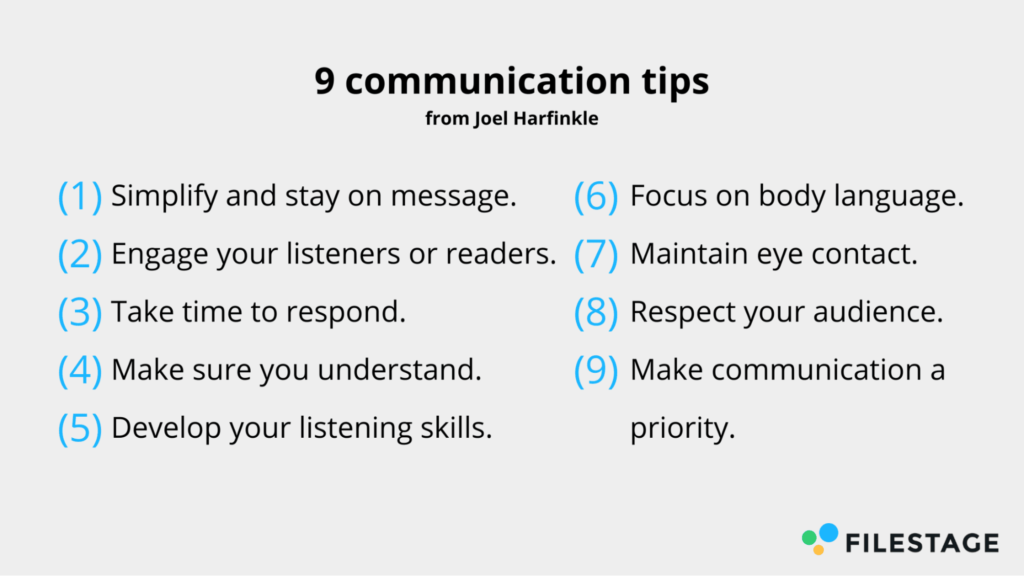
3. Learn to build strong relationships
As the project stakeholder, you act as the center of the network. All of your stakeholder groups will rely on you for instruction and updates, so you have to learn how to develop strong relationships with your colleagues.
This article from Beth Fisher-Yoshida does a great job of outlining five ways to develop more meaningful relationships at work.
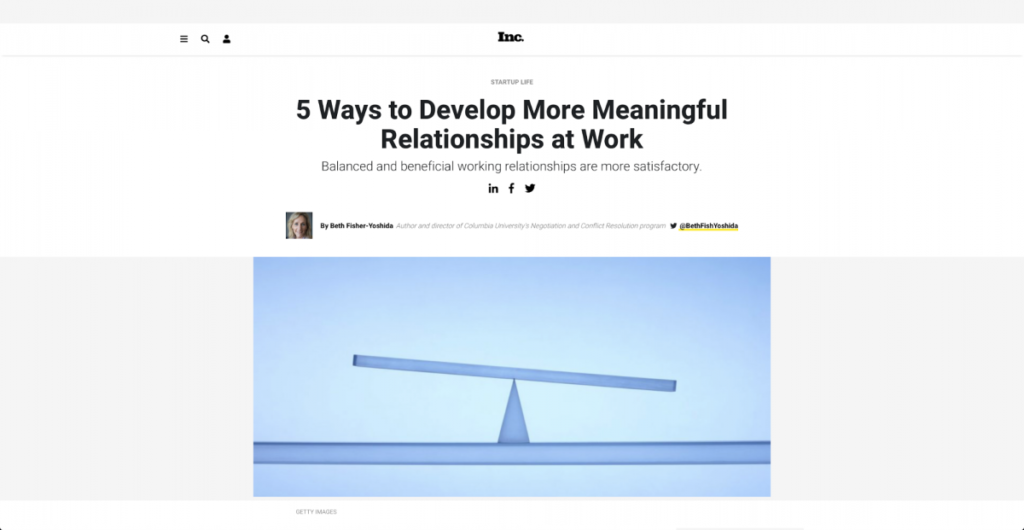
4. Influence your stakeholders
You’re the project manager, so it’s critical that you’re able to champion your own strategy naturally and demonstrate conviction in your own decisions. Rather than responding to the whims of your stakeholders, you must be able to influence them and win them over.
There are a number of project management techniques available to do this. Have you read “How to Win Friends and Influence People” by Dale Carnegie? It’s a great option that’s definitely worth picking up.

5. Quickly retain and share information
Because you’re the project manager, your stakeholders will often ask you questions about the specifics of your project. This means that you’ll have to learn how to retain information quickly, and how to share it so that everyone stays on the same page.
The Science Explorer proposes seven great techniques that you can use to accelerate the speed with which you can memorize and absorb information. You might just find that this article opens up some interesting new avenues for you to explore.

6. Be decisive
One of the most challenging parts of project management is being decisive. Project managers are presented with countless suggestions and options, and you’ve got to learn how to make the right calls for your team and how to stick to your guns.
This video from Time Management and Productivity examines how to develop a strong decision-making process that can make you more decisive.
A stakeholder management example that will inspire you to get started
Stakeholder management is not as complex as it seems and you can achieve great results with simple, consistent steps. Below is an excellent example of a stakeholder management process that can bring impressive results.
Creating product brochures at scale for a range of products
Product brochures are a very effective way for businesses to share the benefits of their products and services. However, businesses often need to produce multiple product brochures, in order to cover their full range and to cater to diverse audiences.
This can result in a challenging project for project managers to handle, even with the use of efficient project management software.
Potential issues when there is no stakeholder management
Here are some of the key issues you might experience when correct stakeholder management is lacking.
1. Conflicting and confusing information
Without proper stakeholder management, inaccurate information could be injected into the project and this, in turn, could affect the accuracy of the final brochures.
Therefore, it is vital that project managers use project planning software to collect the appropriate information from the correct stakeholders. In this way, only proven and accurate information will be reflected in the product brochures.
2. Issues with suppliers
A project manager will also need to handle the printing and distribution of the final brochures. It’s important that those logistics are as flawless as possible and that the printing is done within a strict budget. This can be handled with the right project management tools, to avoid human errors and oversight.
Miscommunication at this stage of the game could prove very damaging to the success of the project, so it’s important that project managers also manage external stakeholders effectively.
3. Unclear approval
Once a brochure goes to print, there’s no going back. If a project manager fails to exercise control over the review and approval processes, the quality of the final brochure can be compromised.
Therefore, it’s critical that project managers manage the review and approval processes successfully, to avoid any mistakes or misinformation going to print.
Filestage helps project managers and other professionals to set up consistent review and approval processes for all your projects. This helps you to share files with stakeholders, collect clear feedback, and track every comment and approval, until it passes the finish line. And the best part, by having all your stakeholders involved on one platform, you can reduce time and the number of review rounds, while increasing transparency.
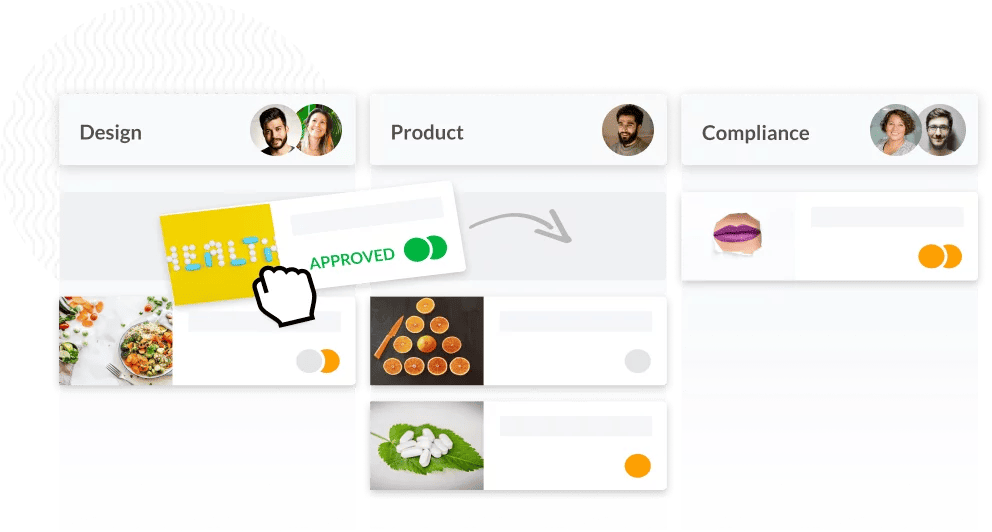
The stakeholder management process for creating a product brochure
Here, we apply the key steps of stakeholder management to the product brochure example:
1. Identify stakeholders
This will be a part of your stakeholder management plan. In this case, your stakeholders would likely be graphic designers, project supervisors, the printing company, logistics partners, customers, etc. Once you identify key stakeholders, you can document, and map them into different groups and prioritize them, according to their interest and power.
2. Communicate and engage with them
Project leaders must always ask the right questions for good stakeholder engagement. What do your stakeholders think of the project? Do they have any ideas? Any issues with the look of the brochures? Do they think anything is missing? Engaging stakeholders makes them feel like a valued part of the project and will yield good results.
3. Monitor and update
Based on your conversations with the stakeholders, you can update your brochures to match any changes they requested and also wait for approval from everyone before printing the final version.
4. Manage grievances
Listen to any grievance or complaints from your stakeholders about the brochures, assess them and resolve them as amicably as possible.
Benefits of stakeholder management
It’s clear that, if a project manager pays close attention to stakeholder management during the brochure project, the entire team will benefit. This is why it makes sense to invest time in planning, at the start of a project.
Are you interested in learning more about how to create the perfect product brochure? Read our piece on how to optimize the design process with a lot of stakeholders.
Conclusion
Stakeholder management is one of the many soft skills that a digital project manager and marketer should possess. It is not about managing difficult people, but creating a professional project environment, where every stakeholder for a particular project feels valued and well-represented.
You can learn how to run successful projects and other digital marketing tactics, but failing to communicate and include your supervisor to get approvals limits your potential as a marketer.
You can only create your best work if you get full support from all stakeholders. So, take the time to manage stakeholders properly and see how it takes your projects to the next level.








